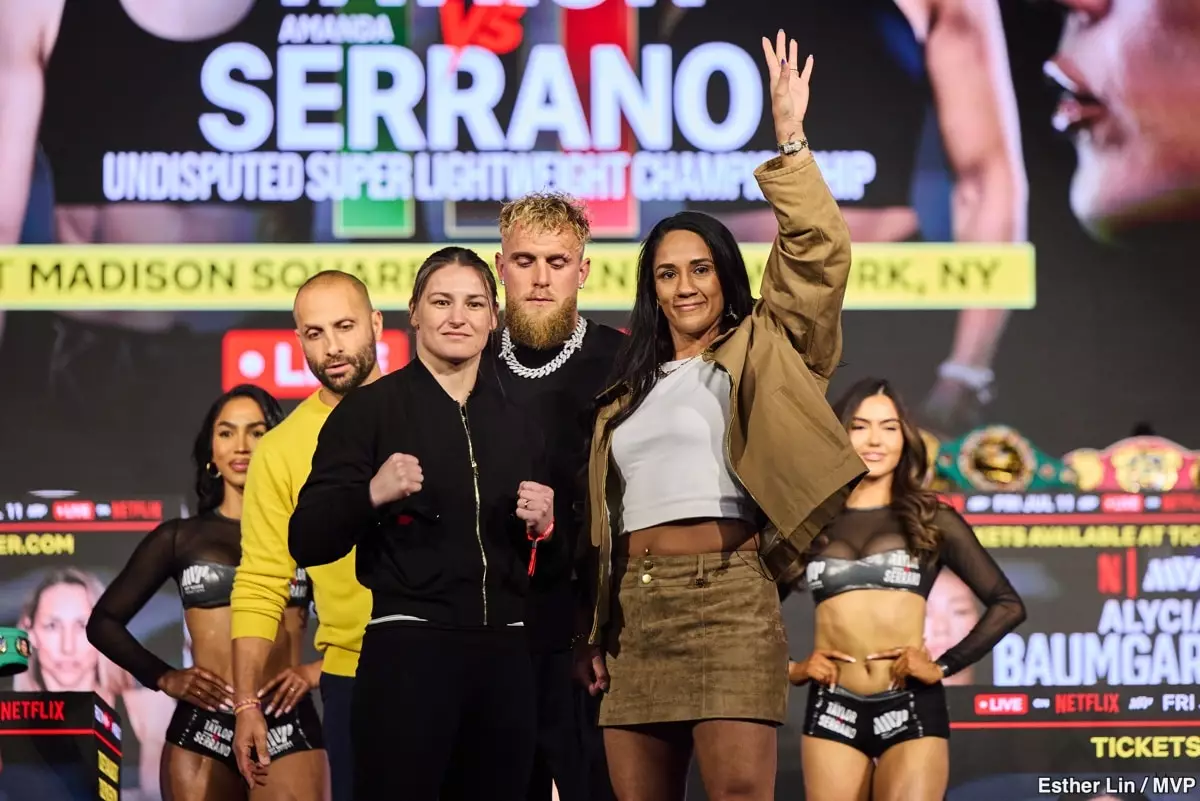In the world of professional boxing, few rivalries captivate audiences quite like that of Katie Taylor and Amanda Serrano. Their dynamic rivalry has not only raised the stakes for female athletes but has also ignited discussions about fairness in women’s sports. As the boxing community eagerly awaits their third encounter, the air is thick with tension, strategy, and pride, each fighter fully aware of the ramifications of a match that could ultimately define their legacies.
The heated discussions surrounding the length of rounds—three-minute segments as opposed to the traditionally allocated two—illustrate a significant disparity in how female boxers are treated compared to their male counterparts. In a recent press conference held in New York, Serrano remarked that she and Taylor had previously agreed to extend the fight to twelve three-minute rounds. This assertion raised eyebrows and revealed the underlying issue of equality in the sport, highlighting that these boundaries still exist even among elite athletes. Serrano passionately expressed her belief that women ought to be granted recognition and opportunities similar to those afforded to male fighters.
The Dynamic of Challengers and Champions
From a tactical standpoint, the argument over fight structure is emblematic of a deeper competitive landscape where perception and strategy intertwine. Taylor, who holds an impressive record of 24 wins with just one defeat, contends that as the reigning champion, she is in a position to set the terms. Her statement brings light to a long-standing principle in combat sports: the champion’s privilege. However, it should also raise questions about the landscape’s evolution. As the world shifts toward greater equality, should champions still possess the authority to dictate terms solely based on their title? Such dynamics may be fair historically, but they often do not align with present-day expectations for equality.
For Serrano, a seasoned fighter with a record of 47 wins, 3 losses, and 1 draw, the desire for a three-minute round isn’t merely a minor detail; it could represent a critical tactical advantage. Her perspective raises an essential conversation about how varying match formats might influence a fighter’s preparedness and performance. Serrano’s belief that the extra minute would allow her to turn the tide in her favor suggests an innovative approach to strategy that warrants deep reflection in the boxing community.
A Battle Beyond the Ring
The verbal sparring between Taylor and Serrano reflects an emotional investment that transcends the confines of the boxing ring. Their exchange reveals not only their competitiveness but also their personalities and backgrounds. Serrano’s cries for equality resonate on numerous levels, particularly in a society increasingly attuned to fairness and recognition in sports. For women in boxing, athleticism and skill should take precedence over archaic traditions that diminish their contributions.
Conversely, Taylor’s retort that Serrano has never scored a knockout in previous twelve-round fights starkly underscores her belief in her own dominance. Yet it also highlights a pertinent problem: knockouts are only one element of a fight’s outcome. The psychological warfare between these two fighters can prove just as compelling as their athleticism. Serrano’s assertiveness plays into her narrative as a challenger determined to overcome the odds, while Taylor’s high-on-confidence retorts encapsulate the mindset of a champion who fiercely guards her legacy.
The Road Ahead
As fight day approaches, the anticipation builds. Fans are left pondering not just the victor, but the broader implications this match will set for women in boxing. Will it finally bring the recognition that female athletes deserve? Or will it serve merely as another chapter in a long story filled with compromise and negotiation?
While both fighters possess formidable skills, the narrative that unfolds in the ring has the potential to shape their careers fundamentally. Taylor versus Serrano III isn’t just about titles or belts; it carries the weight of history, gender equality, and the relentless pursuit of athletic excellence. Thus, as spectators, we should engage with this conflict not merely as a sporting event but as a representation of the larger battle for respect and recognition within female sports—a fight worth rooting for in every sense.

